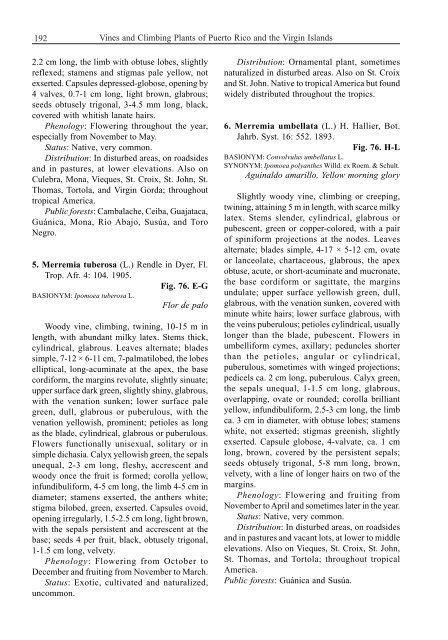Vines and Climbing Plants of Puerto Rico and the Virgin Islands
Vines and Climbing Plants of Puerto Rico and the Virgin Islands
Vines and Climbing Plants of Puerto Rico and the Virgin Islands
Create successful ePaper yourself
Turn your PDF publications into a flip-book with our unique Google optimized e-Paper software.
192<br />
<strong>Vines</strong> <strong>and</strong> <strong>Climbing</strong> <strong>Plants</strong> <strong>of</strong> <strong>Puerto</strong> <strong>Rico</strong> <strong>and</strong> <strong>the</strong> <strong>Virgin</strong> Isl<strong>and</strong>s<br />
2.2 cm long, <strong>the</strong> limb with obtuse lobes, slightly<br />
reflexed; stamens <strong>and</strong> stigmas pale yellow, not<br />
exserted. Capsules depressed-globose, opening by<br />
4 valves, 0.7-1 cm long, light brown, glabrous;<br />
seeds obtusely trigonal, 3-4.5 mm long, black,<br />
covered with whitish lanate hairs.<br />
Phenology: Flowering throughout <strong>the</strong> year,<br />
especially from November to May.<br />
Status: Native, very common.<br />
Distribution: In disturbed areas, on roadsides<br />
<strong>and</strong> in pastures, at lower elevations. Also on<br />
Culebra, Mona, Vieques, St. Croix, St. John, St.<br />
Thomas, Tortola, <strong>and</strong> <strong>Virgin</strong> Gorda; throughout<br />
tropical America.<br />
Public forests: Cambalache, Ceiba, Guajataca,<br />
Guánica, Mona, Río Abajo, Susúa, <strong>and</strong> Toro<br />
Negro.<br />
5. Merremia tuberosa (L.) Rendle in Dyer, Fl.<br />
Trop. Afr. 4: 104. 1905.<br />
Fig. 76. E-G<br />
BASIONYM: Ipomoea tuberosa L.<br />
Flor de palo<br />
Woody vine, climbing, twining, 10-15 m in<br />
length, with abundant milky latex. Stems thick,<br />
cylindrical, glabrous. Leaves alternate; blades<br />
simple, 7-12 × 6-11 cm, 7-palmatilobed, <strong>the</strong> lobes<br />
elliptical, long-acuminate at <strong>the</strong> apex, <strong>the</strong> base<br />
cordiform, <strong>the</strong> margins revolute, slightly sinuate;<br />
upper surface dark green, slightly shiny, glabrous,<br />
with <strong>the</strong> venation sunken; lower surface pale<br />
green, dull, glabrous or puberulous, with <strong>the</strong><br />
venation yellowish, prominent; petioles as long<br />
as <strong>the</strong> blade, cylindrical, glabrous or puberulous.<br />
Flowers functionally unisexual, solitary or in<br />
simple dichasia. Calyx yellowish green, <strong>the</strong> sepals<br />
unequal, 2-3 cm long, fleshy, accrescent <strong>and</strong><br />
woody once <strong>the</strong> fruit is formed; corolla yellow,<br />
infundibuliform, 4-5 cm long, <strong>the</strong> limb 4-5 cm in<br />
diameter; stamens exserted, <strong>the</strong> an<strong>the</strong>rs white;<br />
stigma bilobed, green, exserted. Capsules ovoid,<br />
opening irregularly, 1.5-2.5 cm long, light brown,<br />
with <strong>the</strong> sepals persistent <strong>and</strong> accrescent at <strong>the</strong><br />
base; seeds 4 per fruit, black, obtusely trigonal,<br />
1-1.5 cm long, velvety.<br />
Phenology: Flowering from October to<br />
December <strong>and</strong> fruiting from November to March.<br />
Status: Exotic, cultivated <strong>and</strong> naturalized,<br />
uncommon.<br />
Distribution: Ornamental plant, sometimes<br />
naturalized in disturbed areas. Also on St. Croix<br />
<strong>and</strong> St. John. Native to tropical America but found<br />
widely distributed throughout <strong>the</strong> tropics.<br />
6. Merremia umbellata (L.) H. Hallier, Bot.<br />
Jahrb. Syst. 16: 552. 1893.<br />
Fig. 76. H-L<br />
BASIONYM: Convolvulus umbellatus L.<br />
SYNONYM: Ipomoea polyan<strong>the</strong>s Willd. ex Roem. & Schult.<br />
Aguinaldo amarillo, Yellow morning glory<br />
Slightly woody vine, climbing or creeping,<br />
twining, attaining 5 m in length, with scarce milky<br />
latex. Stems slender, cylindrical, glabrous or<br />
pubescent, green or copper-colored, with a pair<br />
<strong>of</strong> spiniform projections at <strong>the</strong> nodes. Leaves<br />
alternate; blades simple, 4-17 × 5-12 cm, ovate<br />
or lanceolate, chartaceous, glabrous, <strong>the</strong> apex<br />
obtuse, acute, or short-acuminate <strong>and</strong> mucronate,<br />
<strong>the</strong> base cordiform or sagittate, <strong>the</strong> margins<br />
undulate; upper surface yellowish green, dull,<br />
glabrous, with <strong>the</strong> venation sunken, covered with<br />
minute white hairs; lower surface glabrous, with<br />
<strong>the</strong> veins puberulous; petioles cylindrical, usually<br />
longer than <strong>the</strong> blade, pubescent. Flowers in<br />
umbelliform cymes, axillary; peduncles shorter<br />
than <strong>the</strong> petioles, angular or cylindrical,<br />
puberulous, sometimes with winged projections;<br />
pedicels ca. 2 cm long, puberulous. Calyx green,<br />
<strong>the</strong> sepals unequal, 1-1.5 cm long, glabrous,<br />
overlapping, ovate or rounded; corolla brilliant<br />
yellow, infundibuliform, 2.5-3 cm long, <strong>the</strong> limb<br />
ca. 3 cm in diameter, with obtuse lobes; stamens<br />
white, not exserted; stigmas greenish, slightly<br />
exserted. Capsule globose, 4-valvate, ca. 1 cm<br />
long, brown, covered by <strong>the</strong> persistent sepals;<br />
seeds obtusely trigonal, 5-8 mm long, brown,<br />
velvety, with a line <strong>of</strong> longer hairs on two <strong>of</strong> <strong>the</strong><br />
margins.<br />
Phenology: Flowering <strong>and</strong> fruiting from<br />
November to April <strong>and</strong> sometimes later in <strong>the</strong> year.<br />
Status: Native, very common.<br />
Distribution: In disturbed areas, on roadsides<br />
<strong>and</strong> in pastures <strong>and</strong> vacant lots, at lower to middle<br />
elevations. Also on Vieques, St. Croix, St. John,<br />
St. Thomas, <strong>and</strong> Tortola; throughout tropical<br />
America.<br />
Public forests: Guánica <strong>and</strong> Susúa.
















